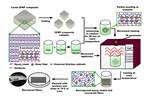Pilot program turns EOL wind blades to liners for pipe infrastructure
TPI Composites, Tex-Tech and Carbon Rivers partner to process wind blades, pyrolyze the material and use the recovered glass fibers to give new life to damaged existing pipelines.
TPI Composites Inc. (Scottsdale, Ariz., U.S.) has partnered with Tex-Tech (Kernersville, N.C., U.S.) and Carbon Rivers (Knoxville, Tenn., U.S.) in a pilot program to process end-of-life (EOL) wind blades, pyrolyze the material and process the recovered glass fiber into liners for cured-in-place pipe (CIPP). CIPP gives new life to damaged pipelines without the excavation of streets through rehabilitation of existing water mains and waste lines by lining the walls of the existing pipe with a hardened synthetic fiber tube.
With this partnership, TPI is able to contribute to a circular economy. The company provides EOL wind blades to Carbon Rivers, which in turn has created a pilot line for the recycling process through high-temperature pyrolysis (read more, “Carbon Rivers to commercialize fiberglass composites upcycling project”). The result is recovery of lightweight hydrocarbons as feedstocks for new products as well the glass fiber, the primary reinforcement in wind blades. These reinforcements are received by Tex-Tech, which then integrates the glass fiber with other materials to create a nonwoven liner, the primary component used in CIPP operations. This liner design is said to significantly increase the properties of the installation, resulting in lower costs and improved long-term performance.

The Tex-Tech product and results from testing conducted by TPI were recently presented at the Underground Construction Technology conference in Orlando, Florida. “We have a strong corporate belief in creating sustainable supply chains that lead to the efficient use of raw materials to reduce overall waste,” Vincent Gallacher, director of research and product development at Tex Tech, says. “Our involvement with TPI and Carbon Rivers, establishes a path for reuse of end-of-life wind turbine blades which exemplifies this principle for the betterment of our customers, our company and society.”
Observed by David Morgan, chief strategy officer at Carbon Rivers, “Upcycled glass fiber circular economies are not just necessary for wind energy, automotive and marine industries but recovered materials are also essential for infrastructure and underground pipe systems. The property enhancements from the use of recycled glass fiber in these applications is an innovative step.”
Related Content
-
Al Seer Marine, Abu Dhabi Maritime unveil world’s largest 3D-printed boat
Holding the new Guinness World Record at 11.98 meters, the 3D-printed composite water taxi used a CEAD Flexbot to print two hulls in less than 12 days.
-
Aviation-specific battery system uses advanced composites to address electric, hybrid flight
BOLDair’s composite enclosure, compression structures and thermal runaway management enables high-performance electric energy storage.
-
Bioabsorbable and degradable glass fibers, compostable composite parts
ABM Composite offers sustainable options and up to a 60% reduction in carbon footprint for glass fiber-reinforced composites.












.jpg;maxWidth=300;quality=90)
